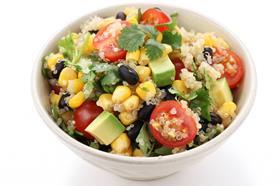
A sure sign that a food fad is here to stay is when the major retailers get on board in a big way. This year, it’s the turn of exotic salads, as Tesco recently announced it has trebled its on-the-go salad range to more than 50 lines.
Tesco said the move follows new data that shows the lighter salad market is growing around three times as fast as the lunchtime sandwich market. In addition to more shelf-space, new and exotic ingredients are finding their way into the humble leafy salad mix, leading to plenty of opportunities for innovative salad suppliers.
“Previously seen as a meal accompaniment, salad is now taking centre-stage as a main meal in itself and consumers are demanding more from the in-store salad fixture,” says Sarah Baldock, category and innovation director at Natures Way Foods (NWF). “Consequently, salads not only have to provide a healthy and nutritious meal solution, but must now also deliver against taste, quality and texture.
“As such, retailers and suppliers have capitalised on this demand by investing heavily in innovation within the dressed salad and food-to-go sectors by incorporating more protein, grains and pulses within their ready-prepared salad offerings to stand out against convenience food competitors.”
Baldock says NWF is currently working on a big piece of consumer insight on the exotic salads sector, to better understand “how far the consumer wants to go with emerging and new ingredients, flavours and pack formats”. For now, she says younger generations are keen to explore more exotic flavours, while cookery programmes are raising awareness about new ingredients. “Kale has hit mainstream retailers in a big way and is now being incorporated into dressed salad and food-to-go products; the addition of wild herbs and edible flowers have also proved popular and add depth to simple salad dishes,” she adds.
Another giant in the own-label exotic and dressed salad sector is prepared produce firm Bakkavor. A spokesperson for the company says: “Health, freshness, fruit additions, dressings in pots allowing for personalisation, grains, and extra flavour from ingredients such as micro herbs and pickled ginger are all current trends. Exotic flavours such as soy, ginger, and authentic ingredients, such as edamame beans, also feature, as well as protein pots, and small pots so consumers can pick and mix.”
Asked what retailers are looking for in current NPD for exotic salads, the spokesperson replies: “Fresh healthy ingredients, variety, products that inspire shoppers, but importantly products that are satisfying – no one wants to still be hungry once they’ve eaten lunch.”
Other produce companies are capitalising on the growth in this sector through investing in their own facilities to handle protein, grains as well as produce. Lincolnshire-based snack and salad specialist Freshtime has an on-site protein-handling facility, as well as a development kitchen, and marketing data analyst Callum Albrighton explains how the company is proactive in researching new trends and ingredients. “We are attending innovation sessions with suppliers to keep up with developments on ingredients, attending trade shows and visiting stores to understand new products, and reviewing developments outside of our product categories to see how new trends are being developed.
“Products need to look full and provide value for money. They must also give consumers plenty of choice, personalisation elements, wide appeal and a variety of uses,” he says, adding that the ‘next big thing’ is likely to be novel grains, kale and raw vegetables, notably broccoli and cauliflower. “The final area of growth is anticipated to be through the introduction of kale into prepared salads. Although this has started, it is expected that the range of kale salads on retailers’ shelves will increase as we move on into 2016,” he adds.
Despite the obvious popularity of exotic salads – the growth of chains like Pret A Manger and Eat are testament to this – Baldock believes it’s still early days for consumers, many of whom are still undecided as to flavour or packing preference. This is both beneficial, as there is scope for innovation, but also brings challenges to suppliers, who cannot be sure what will succeed. And with the multiple retailers getting on board, they will want guarantees of successful products in return for shelf-space.
“The key category challenge is understanding the shopper mission and eating occasion, while ensuring that the product, packaging, retail space and store position genuinely reflect what shoppers want,” she says. “The consumer is confused about what dressed salads are to be used for and are currently using across a number of consumption occasions – that makes developing exactly the right product and pack format to meet consumer needs quite a challenge.”
Dressed and exotic salads also offer plenty of opportunities for added-value, not least through novelty ingredients such as pomegranate seeds or mango chunks. Albrighton explains: “Further trends in the prepared salads category include the increase in the number of products that have a dressing in a pot to accompany the salad. “The main reason for this is that retailers and suppliers have acknowledged that the amount of dressing customers want on their salad varies from customer to customer.”



